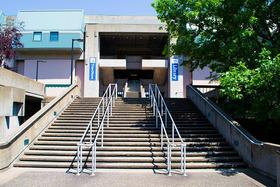- Brown Mackie College ? Akron provides higher education to traditional and nontraditional students through associate?s degree and diploma programs designed to enhance career opportunities, broaden perspectives through appropriate general education courses, develop critical and independent thinking skills, improve problem-solving abilities and develop an appreciation for lifelong and continued education.
School Highlights
Brown Mackie College-Akron serves 533 students (100% of students are full-time).
The college's student-teacher ratio of 28:1 is higher than the state community college average of 22:1.
Minority enrollment is 42% of the student body (majority Black), which is more than the state average of 38%.
Quick Facts (2025-26)
- Enrollment: 533 students
- Private-state tuition: $12,123
- Student-teacher ratio: 28:1
- Minority enrollment: 42%
- Source: Integrated Postsecondary Education Data System (IPEDS)
School Overview
The teacher population of 19 teachers has stayed relatively flat over five years.
Brown Mackie College-Akron
(OH) Community College Avg.
Carnegie Classification
Associates Colleges
Baccalaureate/Associate's Colleges: Mixed Baccalaureate/Associate's
Institution Level
Less than 2 yrs
At least 2 but less than 4 years
Institution Control
Private, for profit
Private not-for-profit
Total Faculty
19 staff
93 staff
Student Body
The student population of Brown Mackie College-Akron has stayed relatively flat over five years.
The student-teacher ratio of 28:1 has stayed the same over five years.
The Brown Mackie College-Akron diversity score of 0.55 is less than the state average of 0.58. The school's diversity has stayed relatively flat over five years.
Total Enrollment
533 students
757 students
Student-Teacher Ratio
28:1
22:1
# Full-Time Students
533 students
397 students
# Part-Time Students
n/a
360 students
# Enrollment Undergraduate
598 students
313 students
# Full-Time Undergraduate Students
533 students
385 students
# Full-Time Graduate Students
n/a
10 students
# Part-Time Undergraduate Students
n/a
434 students
# Part-Time Graduate Students
n/a
3 students
Total Dormitory Capacity
n/a
425 students
% American Indian/Alaskan
1%
n/a
% Asian
2%
4%
% Hispanic
2%
6%
% Black
34%
15%
% White
58%
62%
% Hawaiian
n/a
2%
% Two or more races
n/a
4%
% Non Resident races
n/a
1%
% Unknown races
3%
6%
Diversity Score
0.55
0.58
College Completion Rate (Students who graduate in less than 4 years)
18%
31%
College Completion Rate (Students who graduate in 4 years or more than 4 years)
n/a
22%
Average Graduate Earnings (10 Years)
$30,300
$31,900
Tuition and Acceptance Rate
The private state tuition of $12,123 is less than the state average of $14,014. The private state tuition has grown by 9% over four years.
Private State Tuition Fees
$12,123
$14,014
% Students Receiving Some Financial Aid
98%
92%
Median Debt for Graduates
$22,141
$20,581
Median Debt for Dropouts
$6,625
$7,090
Acceptance Rate
n/a
73%
SAT Reading
n/a
460
SAT Math
n/a
475
SAT Writing
n/a
465
ACT Composite
n/a
21
ACT English
n/a
20
ACT Math
n/a
20
Source: 2023 (or latest year available) Integrated Postsecondary Education Data System (IPEDS)
School Notes
- Brown Mackie College ? Akron is a branch of Brown Mackie College ? Cincinnati, OH. Founded as AEC Southern Ohio College, the school has a long history offering career education and training, going back to its establishment as a traditional business college in 1927. In 2003, the parent corporation of AEC Southern Ohio College was acquired by Pittsburgh-based Education Management Corporation (EDMC), and in 2004, AEC Southern Ohio College changed its name to Brown Mackie College ? Akron. EDMC, which has been in business for over 40 years, is one of the largest providers of private postsecondary education in North America, with an enrollment exceeding 58,000 students at 67 locations in the United States and Canada. Brown Mackie College ? Akron believes that it makes an important contribution to the economic growth and social well being of the metropolitan area it serves. The College educates students to help meet the economic needs of the communities in entry-level positions in business, technical, and allied health careers. Brown Mackie College ? Akron serves approximately 500 students with an average class size of 25-30 students. We pride ourselves on the close attention that our faculty and staff offer our students. With a student/faculty ratio of approximately 17 to one, we offer lots of support and guidance to ensure our students' academic success. The Brown Mackie College ? Akron facility includes three networked computer labs, two medical labs, one electronics lab, one networked MCSE lab, and one networked comp/CADD lab. The labs provide students with hands-on opportunities to apply knowledge and skills learned in the classroom. Students are welcome to use the labs when they're not being used for scheduled classes. Brown Mackie College ? Akron is accredited by the Accrediting Council for Independent Colleges and Schools (ACIS).
Frequently Asked Questions
How much does Brown Mackie College-Akron cost?
Brown Mackie College-Akron's private state tuition is approximately $12,123.
In what neighborhood is Brown Mackie College-Akron located?
Brown Mackie College-Akron is located in the West Akron neighborhood of Akron, OH.
Recent Articles

Best Community Colleges by Career Path in 2025
Explore top community colleges for career-training programs in 2025, including healthcare, IT, skilled trades and business pathways.

Dual Enrollment in High School: Benefits, Risks & Real Student Results
Explore the pros and cons of dual enrollment in high school, real outcomes for students in 2025, and how to decide if it’s right for you.

How to Transfer from Community College to a Four-Year University Without Losing Credits
Learn how to transfer from community college to a four-year university in 2025 without losing credits. Expert advice, timelines, and credit-transfer strategies.






